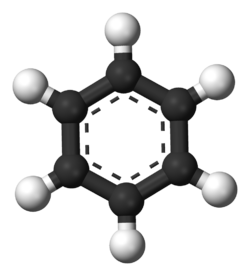| |||
 | |||
| Names | |||
|---|---|---|---|
| Preferred IUPAC name (2H6)Benzene [1] | |||
| Identifiers | |||
3D model (JSmol) | |||
| 1905426 | |||
| ChEBI | |||
| ChemSpider | |||
| ECHA InfoCard | 100.012.784 | ||
| EC Number |
| ||
PubChem CID | |||
| UN number | 1114 | ||
CompTox Dashboard (EPA) | |||
| |||
| |||
| Properties | |||
| C62H6 or C6D6 | |||
| Molar mass | 84.1488 g mol−1 | ||
| Density | 0.950 g cm−3 | ||
| Melting point | 7 °C; 44 °F; 280 K | ||
| Boiling point | 79 °C; 174 °F; 352 K | ||
| Thermochemistry | |||
Heat capacity (C) | 152.46 J K−1 mol−1 | ||
| Hazards | |||
| GHS labelling: | |||
   | |||
| Danger | |||
| H225, H304, H315, H319, H340, H350, H372 | |||
| P201, P202, P210, P233, P240, P241, P242, P243, P260, P264, P270, P280, P281, P301+P310, P302+P352, P303+P361+P353, P305+P351+P338, P308+P313, P314, P321, P331, P332+P313, P337+P313, P362, P370+P378, P403+P235, P405, P501 | |||
| NFPA 704 (fire diamond) | |||
| Flash point | −11 °C (12 °F; 262 K) | ||
| Related compounds | |||
Related compounds | Benzene | ||
Except where otherwise noted, data are given for materials in their standard state (at 25 °C [77 °F], 100 kPa). | |||
Deuterated benzene (C6D6) is an isotopologue of benzene (C6H6) in which the hydrogen atom ("H") is replaced with deuterium (heavy hydrogen) isotope ("D").



